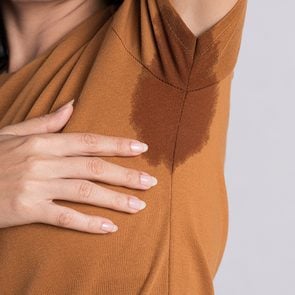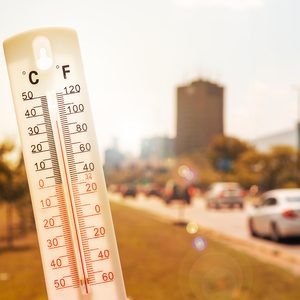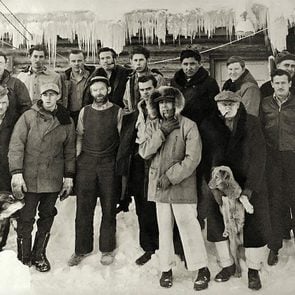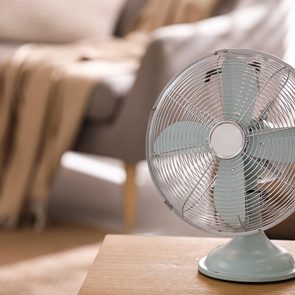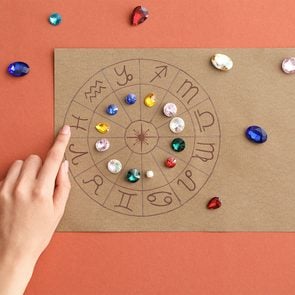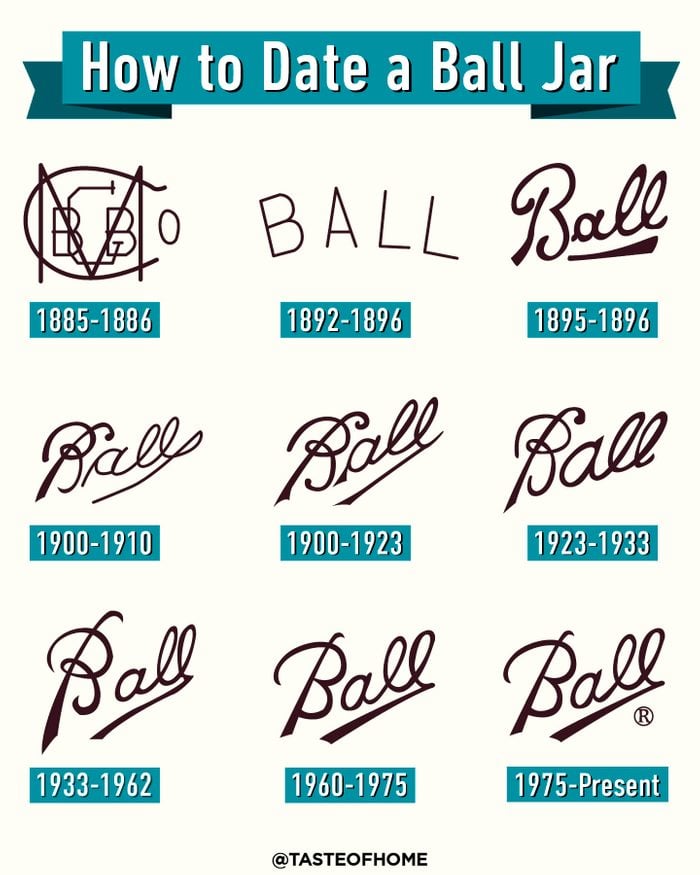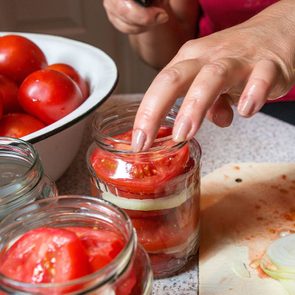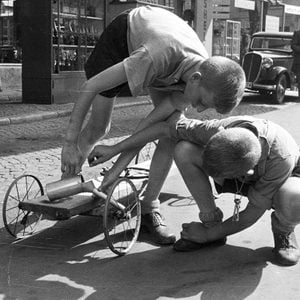
July’s Most Anticipated New Release
Fear Street Trilogy. Billed by Netflix as the “event of the summer,” this adaptation of R.L. Stine’s hit horror novels is split into three movies, each debuting on a Friday starting July 2. An evil force has plagued Shadyside, Ohio, for centuries, and in 1994, 1978 and 1666, residents try to learn the truth behind the town’s horrific curse. And despite Stine’s novels being aimed at a teenage audience, it’s been reported that the Netflix adaptations will lean hard into gory rated-R territory. Welcome to the return of good old-fashioned slasher fare.

New Movies on Netflix Canada in July
July 1
Audible (2021, sports documentary)
Beetlejuice (1988, Fantasy comedy)
The Debt (2010, Thriller)
Disturbia (2007, Thriller)
Dynasty Warriors (2021, Action and adventure)
Eyes Wide Shut (1999, Erotic mystery)
Five Feet Apart (2019, Romantic drama)
I’ll See You in My Dreams (2015, Comedy-drama)
The Impossible (2012, Disaster drama)
Jane Eyre (2011, Romantic drama)
John Wick: Chapter 3 – Parabellum (2019, Action)
Larry Crowne (2011, Romantic comedy)
Moneyball (2011, Sports drama)
Morning Glory (2010, Romantic comedy)
Outbreak (1995, Disaster drama)
Spy Kids (2001, Action-comedy)
Spy Kids 2: The Island of Lost Dreams (2002, Action-comedy)
Spy Kids 3: Game Over (2003, Action-comedy)
Spy Kids: All the Time in the World (2011, Action-comedy)
Up in the Air (2009, Comedy-drama)
War of the Worlds (2005, Science fiction)
Wild Rose (2018, Musical drama)
July 2
The 8th Night (2021, Mystery)
Fear Street Part 1: 1994 (2021, Horror)
Hassen Dillruba (2021, Bollywood)
Now You See Me (2013, Heist thriller)
July 7
Fast Times at Ridgemont High (1982, Teen comedy)
Little Fockers (2010, Comedy)
Major Grom: Plague Doctor (2021, Action)
Meet the Fockers (2004, Comedy)
Meet the Parents (2000, Comedy)
Peter Pan (2003, Fantasy)
July 9
Fear Street Part 2: 1978 (2021, Horror)
How I Became a Superhero (2021, Action)
Last Summer (2021, Romantic drama)
July 11
It: Chapter Two (2019, Horror)
July 13
Trust (2010, Thriller)
July 14
A Classic Horror Story (2021, Horror)
Gunpowder Milkshake (2021, Action)
Private Network: Who Killed Manuel Buendía? (2021, Documentary)
July 15
A Perfect Fit (2021, Romantic drama)
The Final Girls (2015, Horror comedy)
My Amanda (2021, Romantic drama)
Top Gun (1986, Action)
July 16
Deep (2021, Thriller)
Fear Street Part 3: 1666 (2021, Horror)
July 17
Cosmic Sin (2021, Science fiction)
July 20
Milkwater (2020, Drama)
July 22
9 to 5: The Story a Movement (2021, Documentary)
July 23
Bankrolled (2021, Comedy)
Blood Red Sky (2021, Action and adventure)
Kingdom: Ashin of the North (2021, Action and adventure)
The Last Letter From Your Lover (2021, Romantic drama)
Wrath of Man (2021, Heist thriller)
July 26
The Goldfinch (2019, Drama)
July 27
The Angry Birds Movie 2 (2019, Comedy)
The Last Black Man in San Francisco (2019, Drama)
July 28
Bartkowiak (2021, Action)
July 29
Resort to Love (2021, Romantic comedy)
July 30
Anna (2019, Action)
The Last Mercenary (2021, Action comedy)

New Shows on Netflix Canada in July
July 1
A.P. Bio (Comedy)
Generation 56K (Comedy)
Young Royals (Drama)
July 5
You Are My Spring (Romantic drama)
July 7
Cat People (Documentary)
The War Next-Door (Comedy)
July 8
Elize Matsunaga: Once Upon a Crime (Documentary)
July 9
The Cook of Castamar (Drama)
July 14
Heist (True crime)
My Unorthodox Life (Reality)
July 21
Sexy Beasts (Reality)
Too Hot to Handle: Brazil (Reality)
July 28
The Snitch Cartel: Origins (Crime thriller)
Tattoo Redo (Reality)
July 30
Myth & Mogul: John DeLorean (Documentary)

Returning Shows on Netflix Canada in July
July 2
Mortel: Season 2 (Fantasy thriller)
July 6
I Think You Should Leave with Tim Robinson: Season 2 (Comedy)
July 7
Dogs: Season 2 (Documentary)
The Mire: Season 2 (Crime thriller)
July 9
Atypical: Season 4 (Comedy-drama)
Biohackers: Season 2 (Science fiction)
Virgin River: Season 3 (Drama)
July 15
Never Have I Ever: Season 2 (Comedy)
July 16
Explained: Season 3 (Documentary)
Van Helsing: Season 5 (Fantasy horror)
July 21
The Movies That Made Us: Season 2 (Documentary)
July 23
Sky Rojo: Season 2 (Crime drama)
July 26
The Walking Dead: Season 10 (Horror)
July 30
Glow Up: Season 3 (Reality)
Outer Banks: Season 2 (Mystery)
Next, check out the best movies on Netflix Canada!
Is it heat exhaustion or heat stroke? Here’s how to tell the difference
Summer means outdoor fun, ice cream, long days followed by warm nights, and the chance to stock up on some must-have vitamin D. However, it also means taking extra care to look after yourself and your family, including the family pet (be aware of these warning signs of heat stroke in your dog) in the higher temperatures. When the body gets too hot, heat exhaustion can occur—and if that’s not treated it can lead to something much more serious: heat stroke.
According to family physician and assistant professor at Rowan University School of Osteopathic Medicine Jennifer Caudle, DO, the symptoms of heat exhaustion vary but can include muscle cramps, heavy sweating, fatigue or weakness, fast heart rate, nausea or vomiting, and pale or cool skin. “Some of the signs of heat stroke can overlap with heat exhaustion,” says Caudle. “But the difference with heat stroke is that you also have a fever of 105 (or higher) and there is dysfunction of the central nervous system, such as fainting/unconsciousness or seizures.”
“When we discuss heat stroke and heat exhaustion, we are talking about two different problems that exist on a spectrum of heat illness, with heat stroke being a more severe form of heat illness,” explains Neha Raukar, MD, associate professor in Emergency Medicine at Brown University. “Heat exhaustion is on the less severe end of the spectrum of heat illness. It occurs in high temperature environments, and intervention is required, even if that intervention is just taking a break, so the disease does not progress to heat stroke, which can be fatal.” In addition to a high core body temperature, typical symptoms of heat stroke include fainting/dizziness, vomiting, confusion or disorientation, and unusual behaviour, such as aggression.
While heat exhaustion doesn’t normally require medical attention, it’s important to treat the symptoms immediately. This involves moving to a cooler location, sipping water, and applying cool, wet clothes to as much of the body as possible. When it comes to heat stroke, however, Raukar advises calling 911 immediately for appropriate medical attention. “Current treatment methods include cooling blankets, cold-water immersion, application of ice packs, and evaporative cooling with fans and misting,” she says.
Since heat exhaustion and heat stroke exist on the same spectrum of illness, Raukar’s recommendations for avoiding them are the same: Avoid strenuous activity in hot temperatures (such as exercising, mowing the lawn, or playing sports), wear loose, light clothing, seek out shade or air conditioning if you think you are getting overheated, and sip water or cool fluids to help keep the body cool.
Next, check out 20 tricks to keep your house cool without air conditioning.
The year was 1937. Canada was in the midst of the Great Depression, which saw the national unemployment rate peak at 40 per cent. On top of that devastating economic catastrophe, the Canadian and American prairies were also experiencing nearly a full decade of extreme drought, which further threatened the livelihood of farmers.
That summer’s unbearably hot weather would peak on July 5th, when two small towns southeast of Regina recorded the highest temperatures in Canada up to that point. On that scorching day, the inhabitants of Midale and Yellowgrass watched the mercury reach 45.5 degrees Celsius, or about 113 degrees Fahrenheit. That record wouldn’t be topped until June 27, 2021, when Lytton, B.C., reached 46.6 degrees Celsius, or about 116 degrees Fahrenheit.

Life in the dust bowl
Dry spells had been a persistent feature of the prairies since settlement and homesteading began in in the 1870s, but the dry spells of the 1930s were notorious for the scale—both in terms of duration, and area affected. The dust bowl, as the period (and region) is often called, coupled with the worldwide economic downturn, meant that times were tough for the Canadians who called it home—a marked change from the decade prior.
In the 1920s, western Canada was prosperous, and their good fortune was bolstered by wheat exports. Suddenly, both the abundance of wheat and the price of the crop plummeted, leading to an especially harsh existence for those who remained. The drying winds whipped up loose soil and created massive dust storms that made outdoor activity uncomfortable, if not impossible. The dust would settle everywhere: homeowners got in the habit of hanging wet sheets over doorways and setting tables with the cups upside-down until needed, but the dust got in nonetheless and covered everything with a thick film.
Even in places that were spared dust storms, the heat stunted the crops and prevented the bountiful yields that farmers in the Canadian breadbasket had become accustomed to. The situation was so dire that two-thirds of farmers in Saskatchewan lined up for monthly aid from the government. An account in Ten Lost Years, a collection of oral histories from the Great Depression in Canada, described the dust bowl as “survival of the fittest, and I read my Bible more now than I ever did and I never read of hard times like that, like we had in the middle of the Thirties. They was Dirty Thirties all right.”

How hot is hot?
It’s hard to imagine exactly how hot 45 degrees Celsius is—especially in a country that’s at least partly defined by its tolerance to extreme cold. According to the Regina Leader-Post, which recorded first-hand accounts of the extreme heat event, the asphalt streets turned gooey, candles began to go limp on mantles, gramophone records melted in storefront displays, car radiators boiled over and rubber tires softened in the heat. As for the classic heat test, whether it was hot enough to fry an egg on the sidewalk, a resident from Weyburn, Saskatchewan (another southern Saskatchewan town experiencing extreme heat that day) reportedly tried and told the Leader-Post, “it evaporated and dried up before it had a chance to cook.”
Aside from cooking eggs and melting tires, extreme heat can also be deadly for humans. In scorching conditions such as those as witnessed on July 5, 1937, the human body goes into overdrive trying to cool down, which can lead to heat stroke. These days, once the mercury rises to potentially hazardous levels, health advisories are issued, warning Canadians to stay indoors and drink plenty of water.
If the hottest temperature in Canada has you breaking a sweat, cool down with this look back at what happened in 1816—the year Canada didn’t have a summer.
During this pandemic, you hear about folks making the most of their extra time by learning a new language or starting a vegetable garden from scratch. Me? I’m using the opportunity to switch to natural deodorant.
If that sounds underachieving, consider this.
Ever since I was kid, I’ve been a sweaty person. Even at 34, I’m still hyper-aware of my body odour, and have harboured serious doubts about natural deodorant being up to the job. Nevertheless, I know it’s the healthier choice. Conventional antiperspirants use aluminum and parabens—among other chemical ingredients—to plug pores. Natural deodorants, on the other hand, rely on botanical ingredients that allow the good bacteria in your pits to flourish so that—eventually—you’ll be less stinky than before.
The key word there is “eventually.” From everything I’ve read on the subject, there’s a transitional phase (complete with transitional smells) as the botanical odour blockers work on your body chemistry. Apparently, it can take up to four weeks for your natural deodorant to kick in—if it does at all—which made our current state of social distancing the perfect time to try this switch.
Choosing a natural deodorant
My first challenge was to choose a natural deodorant that wouldn’t irritate my sensitive pits, so I asked friends of mine who preach the gospel of natural deodorant for recommendations in a group chat. One swore by No Pong, a Canadian-made deodorant that uses a blend of coconut oil, beeswax and baking powder. The ingredient list looked promising, but it lost me at the application: the creamy formula comes in a tin and has to be massaged into your pits by hand. No thank you.
Another vouched for Vapour AER Next Level deodorant in Palo Santo Blood Orange, which sounded luxurious—and had a price tag to match. $30 for a stick of deodorant? Hard pass.
The final recommendation was Weleda’s Citrus 24h roll-on deodorant. It turns out it’s available at my local grocery store, comes in a roll-on format (my fave), smells like a citrus-forward gin and tonic (another fave) and costs less than $10. I had my winner.

Day One
This natural deodorant wasn’t in for an easy first day on the job. Having just moved in to a new home, I’d planned some serious painting projects that would truly put this product through its paces.
Post-shower, I gave my underarms several passes of the roll-on. The first sign I overdid it was my husband asking if I was wearing a new fragrance when I walked by. This coming from a man who is “nose blind” to most scents.
Alas, that heavy, heady scent was not to last. As I moved around the house with my paint roller, I noticed a funky smell start to crop up around midday. With my arms over my head for most of the day, there was no concealing it—the funk was turning into stank. I promptly applied a second coat (of natural deodorant, not paint) and it was smooth sailing for the rest of the day.
Not bad, all in all. My workouts are normally pretty fierce, but painting had me sweating even harder than my regular routine, so I was prepared to cut the deodorant some slack.
Week Two
For the most part, week one went—and smelled—pretty good. Week two, however, is when the stank hit the fan.
Is this how much human beings actually sweat without antiperspirant, I wondered? By this point, I was sweating so much, I was having to change my shirt by noon every day. It wasn’t just the discomfort of feeling like a moist rag—I smelled like one too. The smell was familiar, but it had been a while since my own body odour had filled my nostrils with such intensity, triggering long-forgotten shame and anxiety that I hadn’t known since I was in middle school.
I texted a friend who had recently transitioned to natural deodorant and asked her if the excess sweat was normal. She assured me it was all part of the process and explained that since I’m not using antiperspirant anymore, my sweat glands are no longer blocked. The unclogged glands are now overcompensating, producing more sweat and, in turn, generating more odour-causing bacteria. “It’s only temporary,” she said soothingly, suggesting that I wash my underarms with soap and water when things start to get smelly in order to keep the bacteria at bay.
I ended up buying a charcoal soap from Kaia Naturals that’s designed to pair with natural deodorant. I discovered that washing my underarms before applying my roll-on really cut down on the smell, but the sweat itself was still coming in hot.
Week Three
By the start of week three, my B.O. had begun to fade, but the excessive sweat was still an issue—especially after my morning run.
Running had been my salvation during quarantine. Every day at 6:30 a.m., I’d pound the pavement for a meditative sweat sesh. Trouble was, several hours after I’d got home and showered, with a fresh coat of natural deodorant applied to my squeaky clean underarms, my sweat glands were still flowing like faucets—and I was tired of it. I’m not going lie; there were a few moments when I was tempted to reach for my husband’s antiperspirant. I just wanted to smell good again.
I reached out to my natural deodorant support group via chat and told them I was heading for a relapse. Everyone told me to stay the course, but I needed a solution—stat. Perhaps realizing how close I was to falling off the wagon, a friend who’s a yoga instructor suggested I try an “armpit detox.” She swore to me that the detox—a do-it-yourself topical solution—helped change the way her body responded to aluminum-free products. I was skeptical, but also desperate.
After some light Googling, I settled on an armpit detox recipe that sounded harmless enough: 1 tsp of apple cider vinegar (is there anything it can’t do?), 1 tbsp of bentonite clay (available at most health food stores), and 2 tbsp of water, mixed into a paste. I whipped up a batch, applied the paste to my pits—and then realized I’d have to keep my arms raised for 20 minutes. Cut to me lying topless on the bathroom floor. After only five minutes, however, my underarms were on fire, so I jumped in the shower to wash it off.
The attempt at the “detox” was an epic fail that left me with underarms that weren’t just red and stinging, but now reeking of apple cider vinegar.

Week Four
Around day 22, things started to balance out: the amount I perspired was noticeably returning to normal, and my natural deodorant was keeping pace during the day. By the evenings, however, I would occasionally catch a faint whiff of my brand of body odour, which means that post-pandemic, I’m going to have to pack a roll-on in my purse for a midday emergency “pit stop.” As inconvenient as that might sound, I’m willing to take that extra step to limit the amount of potentially harmful chemicals in my grooming routine. I’ve come to accept that a natural deodorant will probably never be able to mask my body odour entirely, and it certainly can’t stop or even reduce sweat. For now, I’m okay with the added moisture and the need for afternoon reapplication. After all, a little B.O. never hurt anyone—especially when you’re living with someone who’s nose blind.
Next, check out pro tips on how to sweat less this summer.
Hello, summer. Cue hot days at the beach, the pool, the park, or a classic backyard barbecue. Another unforgettable and less enjoyable staple of summer? More sweat.
You may feel like those sweat-drenched shirts and sweat stains are an embarrassment, but sweating actually serves a purpose.
“The primary reason we sweat is thermoregulation, the control of body temperature,” explains Brian Ginsberg, MD, board-certified dermatologist at Chelsea Skin & Laser, and clinical assistant professor of dermatology at Mount Sinai Hospital in New York City. “When we get too hot, sweating helps to cool the body down.” While sweating also helps to hydrate the skin and maintain our fluid-electrolyte balance, the end result can be uncomfortable.
According to Shahinaz Soliman, MD, family practice physician, owner of Soliman Care Family Practice Center in Torrance, California, the human body has two- to four-million sweat glands in the underarms, feet, palms, groin, and forehead. “When you sweat and it evaporates, it takes the heat with it.”
Follow these simple fixes to sweat less in summer and keep your cool.
Apply antiperspirant at night
Deodorant and antiperspirant might be thought of as interchangeable, but they each have distinct uses. “Deodorants alone are merely fragrance, whereas antiperspirants serve to reduce sweating,” explains Dr. Ginsberg, adding, “Specifically, antiperspirants contain an ingredient that forms a plug in the sweat glands. Prescription-strength antiperspirants do this more effectively.”
Nikhil Dhingra, MD, board-certified dermatologist at Spring Street Dermatology in New York City agrees: “It’s inexpensive and highly effective at decreasing the odour-causing apocrine sweat. This does require the use of aluminum in your antiperspirant, which essentially interacts with sweat to create a salt that physically blocks the exit point for sweat, and this can last a number of hours.”
In order to get the most from your antiperspirant, apply to dry skin at night. “Your antiperspirant—with or without deodorant—should be applied at nighttime when your sweat production is lowest so it has the best chance of actually blocking those sweat glands,” explains Dr. Dhingra, who also recommends those with sensitive skin avoid fragrances due to the thinness of underarm skin. “The use of deodorizing fragrance-rich products is generally best avoided as the alcohol-based fragrances are usually the main culprit of itchy irritating reactions from deodorants.”

Use a hairdryer after applying deodorant
Especially sweaty? Dr. Ginsberg recommends using a hairdryer after applying deodorant—using the cool setting. He adds: “High-strength antiperspirants should be applied at night time, at first every night, and then spaced out to the needed frequency. A non-medicated deodorant can be added in the morning if desired.”
Avoid food and drinks that make you sweat
While a frosty beer or chilled glass of Rosé might seem like a perfect drink for a hot summer day, neither is the best choice for people prone to sweating. “Alcohol is a common trigger of heavy sweating,” explains Dr. Dhingra, advising the avoidance of both alcohol and caffeine, which can also stimulate sweating, and recommending drinks with electrolytes, instead.
Spicy foods are another category to avoid. “Alcohol, caffeine, and spicy foods are the trinity of sweat-inducing foods to minimize if you sweat heavily,” says Dr. Dhingra. “Alcohol and caffeine stimulate adrenaline production which will quite quickly amplify your sweat production; this is definitely most pronounced for those diagnosed with hyperhidrosis,” otherwise known as excessive sweating.
Dr. Ginsberg doesn’t worry as much about food—with certain exceptions. “Diet does not tend to have a significant impact on sweating, except in the case of gustatory sweating: The small drops of sweat on the forehead, nose, and lip after eating hot, spicy food,” explains Dr. Ginsberg.
Get a prescription to treat hyperhidrosis
If over-the-counter (OTC) methods aren’t working to help get rid of sweat, you might consider visiting your doctor. “You may have hyperhidrosis, which is sweating in excess of what is deemed an average normal amount,” says Dr. Dhingra.
“A misconception regarding this diagnosis is that people with hyperhidrosis have perennial excessive sweating,” explains Dr. Dhingra. “This excessive perspiration can definitely be exacerbated or intolerable in summer months compared to the cooler months where OTC products are sufficient,” he says. In other words, just because you’re sweating excessively in the summer doesn’t necessarily mean it’s a year-round problem, even if you occasionally do require medical intervention.
Of course, it could be another medical condition—such as pregnancy, menopause, an infection, or even heart disease or certain cancers—causing the excess sweat, too, adds Dr. Soliman, making a doctor visit a good bet for safety’s sake.

Oral medications to reduce sweat
Options run the gamut, from topical wipes to prescription topicals to pills to help reduce sweat. “Oral medications (glycopyrrolate and oxybutynin) can be prescribed to reduce sweating, especially when excessive,” says Dr. Ginsberg. While the remedies are usually effective, it’s possible they might come with side effects, including dry mouth, dry eyes, and headache, says Dr. Ginsberg.
New medications for sweat control
New remedies also show promise. “There is also a relatively new topical called Qbrexza which delivers medication that blocks the stimulation of sweat glands by acetylcholine, the neurotransmitter that Botox prevents the release of,” explains Dan Belkin, MD, board-certified dermatologist at Laser & Skin Surgery Center of New York and clinical assistant professor, Ronald O. Perelman Department of Dermatology at NYU Grossman School of Medicine, in New York City. And, as a last resort, surgeries to remove underarm sweat glands also exist to treat hyperhidrosis, adds Dr. Soliman.
Wear breathable clothing to avoid overheating
While it might seem obvious, one of the easiest ways to keep from sweating in the summer is by staying cool in the first place. “Since sweat is triggered by heat, the easiest way to avoid sweating is to avoid overheating,” explains Dr. Ginsberg. “This includes wearing light-weight and breathable clothing, finding shaded or air-conditioned environments, and not over-exerting yourself.” Look for fabrics that promote airflow, such as cotton, linen, or blends, and avoid fabrics such as nylon, polyester, or denim. (Swap your denim pieces for chambray, instead.)
“Sleeveless clothing like dresses, if you’re comfortable doing so, will keep you much cooler than occlusive, warm clothing,” says Dr. Dhingra, adding, “Also allow the feet to breathe; cooler feet can decrease your overall body temperature efficiently, so avoid thick socks and bulky shoes during the warm months.”
Next, check out 20 tricks to keep your house cool without AC.
You already know that Sunday, June 20 was the summer solstice, and marked Father’s Day as well as the official start of summer. Well, get ready for the first full moon of summer, the strawberry moon! Our gorgeous celestial neighbor will be visible in the sky just after sunset this Thursday, June 24. As an added bonus, it’s also the fourth and final supermoon of 2021. That means your social media feeds will be full of moon pictures of varying quality. Instead of trying to photograph it with your crummy phone camera, we recommend just getting outside whenever dusk falls in your location and photographing it with your eyes instead. Look to the East and you’re sure to see some truly magical super strawberry moon goodness. Bring on summer!
What is a strawberry moon?
The name “strawberry moon” comes from Indigenous people in North America, specifically the Algonquin tribes. The Farmer’s Almanac started publishing the Indigenous names for the different full moons of the year in the 1930s. As the first full moon of the summer, the June full moon was called the strawberry moon, in reference to the short strawberry season in the northeast. When the moon is full, it’s time to harvest those delicious berries. Other names for the June full moon in North America include the berries ripen moon, the hot moon, and the egg laying moon. In Europe, the June moon was sometimes referred to as the mead moon or the honey moon.
So it’s not red?
The moon won’t be red exactly, but it could definitely be said to have a pinkish hue, at least when it is first rising. Because it will be near the horizon, the light reflected off the moon will have to travel longer to get to our eyes, compared to when it is directly above us, and will therefore have to travel through more of the Earth’s atmosphere. Red light tends to travel through the atmosphere more easily, which is why sunsets and sunrises are so red, orange, and pink, and why the strawberry moon will look orange or pink when it is first rising. Pollution, dust, and other environmental factors can also influence the colour we perceive the moon to be. Check out fascinating moon mysteries scientists are still trying to figure out.
OK, but what’s a supermoon?
There is no accepted scientific definition for what the moon has to do to qualify as a supermoon. Generally, however, supermoons occur when the moon is full and at perigee, the closest point in its orbit to the Earth. The original definition of a supermoon stated that to be considered super, the moon had to be within 90 per cent of perigee, or 361,766 kilometres. That’s why there are usually several supermoons per year. The moon’s orbit around the Earth is elliptical, which is why it appears at different sizes in our sky.
How to see the strawberry moon this week
Thanks to the recent summer solstice (the longest day of the year) and the fact that the sun and moon orbit on roughly the same plane, the strawberry moon will be particularly low, large, and bright this Thursday, June 24. The Moon will be closer to the horizon, making it appear larger. The fact that it’s in perigee will also add to the luminous effect.
To see the super strawberry moon, you’ll want to get somewhere high up with a good view low to the horizon, facing East. Sunset should be between 8 and 8:30 p.m. depending on where you live in North America, and the moonrise will occur about 20 minutes after that.
If you want to see it before then, the moon will actually be 100 per cent full (i.e. fully illuminated by the sun) at 6:40 p.m. UTC on Thursday, June 24. You can watch it rise over Rome, Italy through the live stream hosted by the Virtual Telescope Project starting at 7:00 p.m. UTC before you head outside later in the evening. Taking some strawberries along with you as a moon-gazing snack is, of course, highly encouraged. Happy summer, everybody!
Next, check out the best stargazing spots across Canada.
Whether you use them for home decor or canning, Mason jars are the most simple (and iconic) form of kitchen storage. They’ve been around for 100+ years and are still going strong! Not only do they have a beautiful, timeless design, but they can even help save the world.
The real question is, what do you know about Ball jar dating? No, not the romantic type—the valuing type! Ball jars from specific decades have their own unique logo, and they’re all worth different amounts.
Ball Mason Jar Age Chart
Lucky for us, this handy chart can help you keep track of all the Ball jar logos. There are about eight different logos in total, starting in the 1880s and finishing in the present day. The original logo, which looks nothing like the following logos, is basically unrecognizable today.
While each set of decades has its own version of the logo we know and love, there are other things to look out for, too. Phrases like “improved,” “special,” “perfect,” “sanitary,” “ideal,” “square” and “eclipse” can all help identify the year of your jar. For example, this Ball Mason jar with the phrase “perfect” on the bottom is approximately from 1913-1922.
Vintage Mason Jar Colours
Mason jars were manufactured in many different colours, including clear, pale blue, yellow, amber, olive and various other greens. (In the early 1900s, people thought darker glass helped prevent food from spoiling as quickly.) The rarest of the jar colours are green and have been known to fetch upwards of $300 per jar—that’s incredible!
How Much is Your Ball Jar Worth?
If you want a quick peek, you can always type in your jar’s credentials into eBay or Etsy and see if you have any that are a match. Some have already sold for as much as $54, like this pale blue wire lock Mason jar from the early 1900s. Some even have logo “misprints,” such as this Ball jar that has three Ls on the front. Overall, it seems the early 1900s jars fetch more than the most recent years, as expected.
Do you have any rare jars? You’ll have to check and see!
Next, find out which Barbie dolls are the most valuable.
 11 Ways to Prevent Pet Heatstroke" width="295" height="295" />
11 Ways to Prevent Pet Heatstroke" width="295" height="295" />